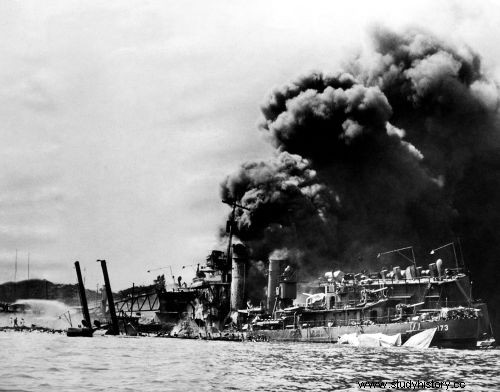
The attack on the US naval base at Pearl Harbor , held on December 7, 1941, marked the beginning of the conflict between the United States and Japan during World War II. This attack was an attempt – failed – to destroy the US naval fleet that was in Hawaii. The complete destruction of the American fleet was essential for Japan to continue its project of conquest and territorial expansion over the Pacific Islands.
The attack on Pearl Harbor was part of the expansion project territory that Japan had put in place since the 1930s, when it started the invasion of China . Japanese imperialism was a consequence of the growth of nationalism, militarism and indoctrination what happened in the country after the Restoration Meiji and the rephrasing from teaching . This indoctrination held that Japan was a nation superior to others and that it had the right to build a great empire from the conquest of other territories through war.
Once World War II began, Japan quickly expanded into other regions of Asia:Singapore, Malaysia, Burma and Indochina, defeating French and British forces. The reports of clashes in these regions record the numerous cruelties and war crimes committed by Japanese soldiers.
Japan-US rivalry
Japan's rivalry with the US dates back to the 1920s. During this period, the United States vetoed a series of Japanese demands on territories in China. Furthermore, the US presence in the Philippines was a nuisance to the Japanese, as this was a region that Japan wanted.
War, which was desired by a considerable part of the population after years of indoctrination, reflected the complete ignorance regarding the economic and war capabilities of the United States. In other words, Japan underestimated the enemy and did not have the resources to maintain a long-term war with the US, mainly due to the great economic and resource drain that it suffered due to the war against China, which had been going on since 1937.
Attack Pearl Harbor
The Admiral Yamamoto , responsible for planning the attack on Pearl Harbor, knew this and was one of the few who had the courage to stand against Japan's hysterical militarism during the 1930s. Japan's objective with the attack carried out on December 7, 1941 was the complete destruction of the American naval fleet in the Pacific, which would give Japan a clear path to expand.
The attack – commanded by Chuichu Nagumo – Pearl Harbor, despite having taken the Americans by surprise and generated a high number of destruction and deaths, was poorly executed. The attack sank some important American ships, but it was far from completely destroying the naval fleet in Hawaii.
In any case, the American naval industry was building new ships at considerable speed and the losses were soon answered. Finally, the attack on Pearl Harbor ended up mobilizing to war a country that until then did not see the conflict with good eyes. Thus, “reality has shown that Nagumo's attack was enough to shock, injure and infuriate the Americans, but not to harm their war capacity. It was therefore a very ill-conceived operation”|1| .
Consequences of the attack
The destruction balance of the attack for the Americans was more than 2000 deaths and about five ships, that sunk, plus many others which were damaged . In Japan, the attack on Pearl Harbor was considered and advertised as a major victory for the Japanese Navy. This act led the United States to declare war on Japan. The Japanese strategy was to impose quick defeats on the United States to force a negotiation and American surrender. However, this did not happen and, a few months after the attack on Pearl Harbor, the United States came to dominate the conflict against Japan, with important victories that took place at the Battle of Midway and in the battle of Guadalcanal between 1942 and 1943. The conflict between the two nations, however, lasted until 1945, when Japan surrendered after the dropping of atomic bombs on Hiroshima and Nagasaki by the United States.
|1| HASTINGS, Max. The world at war 1939-1945. Rio de Janeiro:Intrinsic, 2012, p. 211.
Take the opportunity to check out our video lesson related to the subject:
